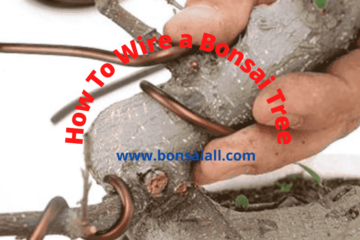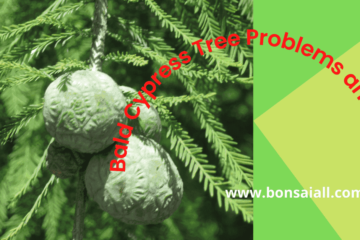Cascading Juniper bonsai represents trees leaning against a hillside or river. The water in the river reflects sunlight onto the tree, causing it to bend that way. It bends downward due to its own weight and snow and natural elements. You can shape your Juniper Bonsai tree in the Cascade Style.
Let’s learn how to shape a cascading juniper bonsai.
What Is Bonsai Cascade Style?
Content Overview
The cascade style of bonsai represents a natural tree growing down the face of an embankment.
In this bonsai style the trunk begins to grow upwards from the ground, then abruptly turns downwards and reaches a point below the lower edge of the pot. For this reason, the pot should be placed on the edge of the table or on a small stand.
Most of the leaves in the cascade style are below the ground.
Cascade style takes longer to train a tree than diagonal style. The best results come from choosing a low-growing species rather than forcing a tree that usually grows upright into an unnatural shape. Bend the whole tree forward so that a back branch is vertical and the side branches fall naturally. The tree should be planted off-center from the cascading sides.
Basics of Shaping a cascading juniper bonsai
Kengai Bonsai is the Japanese term for cascading bonsai. This is a popular bonsai styling technique and gives the tree a waterfall effect. A typical cascade has two parts; A branch grows upwards as normal, while the main branch grows downwards. You will need to wire the branches carefully to keep the shape.
The best juniper varieties for cascades are Chinese juniper, Japanese garden juniper, needle juniper, green mound juniper, and juniper communis.
There are two types of cascade bonsai. In a full cascade, the tip falls below the bottom of its holder; And in a semi-cascade, the tip is somewhere between the base of the plant and the rim of the pot. Chinese juniper is the perfect variety for a semi-cascade style.
To shape your juniper plant into a cascade, you need a tall pot with drainage holes in it. A shallow pot is unsuitable for a cascading juniper bonsai. Grainy soil makes good compost, ideally containing peat, Japanese pumice, orchid bark and black sand. In addition to pruning tools, you should also have some wire on hand to shape the tree.
The Process of Cascading Juniper Bonsai
According to Bonsai Chemist the first thing before you start shaping your bonsai is to take it out of the pot. To do this, turn the pot upside down, grab the plant from above and let it come out naturally.
Once the plant is out of your pot, mark the top and back. Remove half of the branches, including the small branches that grow from the trunk.
Now comes the wiring process. It will help if you wire three-quarters of the tree. Anchor a thick wire around the base of the column. Do not cover it too tightly, as this can damage the plant. Once you have placed the anchoring wire, bend the trunk into a cascading shape.
Cut off about 20-30% of rootlets for potting. Fill them with bonsai soil and plant your bonsai in it. Once you’ve planted it back in the bonsai pot, wire the back column, but not too tightly.
Continue wiring as needed as the plant grows.
Pruning your juniper bonsai
Regular pruning of Juniper bonsai is essential as it keeps the plant in shape and keeps pests at bay. When the trunk begins to grow and swell, you need to remove the wires and reattach the bonsai accordingly. Depending on the rate of growth, you may need to have the wires removed anywhere from three months to a year.
Keep an eye out for any branches that need shortening. To thin out narrow trunks, use small shears. To create small clusters of leaves at the ends of the branches, pinch them using your fingers.
Continue wiring according to the shape of the trunk or more bends if needed.
Once the plant is established, repot your bonsai every three to five years. Also prune the roots each time you repot.
Transfer your cascading Juniper bonsai to a decorative container to enhance its appearance.
Frequently Asked The Question
How do you cascading juniper bonsai?
Cascading juniper bonsai are planted in tall containers. The plant should grow straight for a short stretch but then bend downwards. The crown of the plant usually grows above the rim of the container, but later branches alternate left and right in an S-shaped outward curve of the trunk.
How do you create a cascading juniper bonsai?
The two most popular juniper species for bonsai with scale-like leaves are Chinese juniper and Japanese shimpaku. Japanese shimpaku is actually a variety of Chinese juniper found in the mountains of Japan. From these two varieties make good cascading juniper bonsai easily.
How do you wire a cascade bonsai?
First of all you will need a substrate and a container to grow your plant. From there, you can use soft, flexible wire to shape your tree. You may want to use raffia to protect the plant and further aid in shape. Many people prefer to invest in pruners designed specifically for bonsai because they are so short.
How do you start a cascading bonsai tree?
When starting a cascading bonsai, you will need to add form wires to the plant. 75 percent of the bonsai trunk, starting at the base, is wrapped in a protective covering such as raffia. Anchor a relatively thick wire near the base of the trunk and carefully wrap it around the trunk.
Can you make a bonsai from a juniper?
Repot the root-pruned juniper in a shallow container — often called a training pot — smaller than the 1-gallon container it was growing in but larger than the bonsai pot it will eventually occupy. Make sure there are several drainage holes. Spread the roots over a layer of well-drained bonsai potting soil mix.
What type of juniper is best for bonsai?
Juniperus squamata, also called flaky juniper, has several cultivars that are great for bonsai. Blue Star is one of them. The name comes from the blue-green needles that look like a cluster of stars from a distance. They give off a silvery glow when the sun shines on them.
In Summary
A cascading Juniper bonsai is, without a doubt, a beautiful addition to your space and well worth the effort. Some of the more popular bonsai tree styles are the broom style, windswept bonsai style, diagonal bonsai style, upright style, and forest bonsai style.



